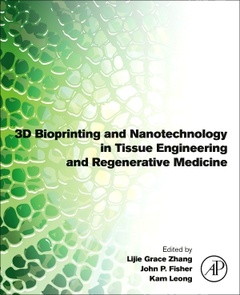Description
3D Bioprinting and Nanotechnology in Tissue Engineering and Regenerative Medicine (2nd Ed.)
Coordinators: Zhang Lijie Grace, Leong Kam, Fisher John P.
Language: English
Subjects for 3D Bioprinting and Nanotechnology in Tissue Engineering...:
Keywords
?3D bioprinting; 3D printing; 3D-printing; 4D bioprinting; 4D printing; Bioink; Biomaterials; Biomechanics; Bioprinting; Blood vessel regeneration; CAD/CAM bioprinting; Carbon nanotube; Cartilage; Cell array; Cells; Copyright; Craniofacial bone; Disease model; Drug screening; Electrospinning; Engineered liver tissue; Extrudability; Extrusion bioprinting; Fused-deposition modeling; Hydrogel; Hydrogels; IP; In vitro culture; Infringement; Inkjet printing; Innovation; Intellectual property; Laser direct-write; Laser-assisted bioprinting; Laser-induced forward transfer; Liver; Liver disease; MAPLE-DW; Microbeads; Microenvironment; Multicellular spheroids; Nanobiomaterial; Nanobiomaterials; Nanofabrication; Nanotechnology; Neural tissue engineering; Osteochondral; Patent; Personalized medicine; Printability; Printing accuracy; Programmable; Regenerative medicine; Responsive; Scaffold; Self-assembly; Shape fidelity; Single-cell printing; Skin; Skin printing; Skin tissue generation; Stereolithography; Subchondral; Tissue engineering; Tissue model; Tissue regeneration; Trade secret; Trademark
562 p. · 19x23.4 cm · Hardback
Description
/li>Contents
/li>Biography
/li>Comment
/li>
3D Bioprinting and Nanotechnology in Tissue Engineering and Regenerative Medicine, Second Edition provides an in-depth introduction to bioprinting and nanotechnology and their industrial applications. Sections cover 4D Printing Smart Multi-responsive Structure, Cells for Bioprinting, 4D Printing Biomaterials, 3D/4D printing functional biomedical devices, 3D Printing for Cardiac and Heart Regeneration, Integrating 3D printing with Ultrasound for Musculoskeletal Regeneration, 3D Printing for Liver Regeneration, 3D Printing for Cancer Studies, 4D Printing Soft Bio-robots, Clinical Translation and Future Directions.
The book's team of expert contributors have pooled their expertise in order to provide a summary of the suitability, sustainability and limitations of each technique for each specific application. The increasing availability and decreasing costs of nanotechnologies and 3D printing technologies are driving their use to meet medical needs. This book provides an overview of these technologies and their integration.
Part I: Principles 1. Nanotechnology: A toolkit for cell behaviour 2. 3D printing and nanomanufacturing 3. 3D bioprinting techniques 4. 4D Printing Smart Multi-responsive Structure 5. The power of CAD/CAM laser bioprinting at the single cell level: evlution of printing 6. Engineering 2D and 3D cellular microenvironments using laser direct-write 7. Cells for Bioprinting 8. Biomaterials for 3D Bioprinting 9. 4D Printing Biomaterials
Part II: Applications: Nanotechnology and 3D Bioprinting for Tissue/Organ Regeneration 10. 3D/4D printing functional biomedical devices 11. Blood vessel regeneration 12. 3D Printing and Patterning Vasculature in Engineered Tissues 13. 3D Printing for Cardiac and Heart Regeneration 14. Craniofacial and dental tissue (metal printing focus) 15. Craniofacial Bone 16. Additive manufacturing for bone load bearing applications 17. 3D printing for cartilage 18. Integrating 3D printing with Ultrasound for Musculoskeletal Regeneration 19. Bioprinting for Skin 20. 3D Printing and Nanotechnology for Neural Tissue Regeneration 21. 3D Printing for Liver Regeneration 22. Organ printing 23. 3D Printing for Cancer Studies 24. 3D Bioprinting, Nanotechnology and Intellectual Property 25. Clinical Translation and Future Directions
Dr. Leong is the Director of Nanotherapeutics and Stem Cell Engineering Laboratory. His research focuses on the development of innovative biomaterials for drug and delivery, nonviral gene editing, and regenerative medicine. He is a member of the National Academy of Engineering, National Academy of Medicine, and National Academy of Inventors, and the Editor-in-Chief of Biomaterials.
Dr. Fisher is the Director of the Tissue Engineering and Biomaterials Laboratory and investigates biomaterials, stem cells, and bioreactors for the regeneration of lost tissues, particularly bone, cartilage, vasculature, and skeletal muscle. In 2012 Dr. Fisher was elected Fellow of the American Institute for Medical and Biological Engineering. Dr. Fisher is currently the co-Editor-in-Chief of the journal Tissue Engineering.
- Includes clinical applications, regulatory hurdles, and a risk-benefit analysis of each technology
- Assists readers in selecting the best materials and how to identify the right parameters for printing
- Includes the advantages of integrating 3D printing and nanotechnology in order to improve the safety of nano-scale materials for biomedical applications




